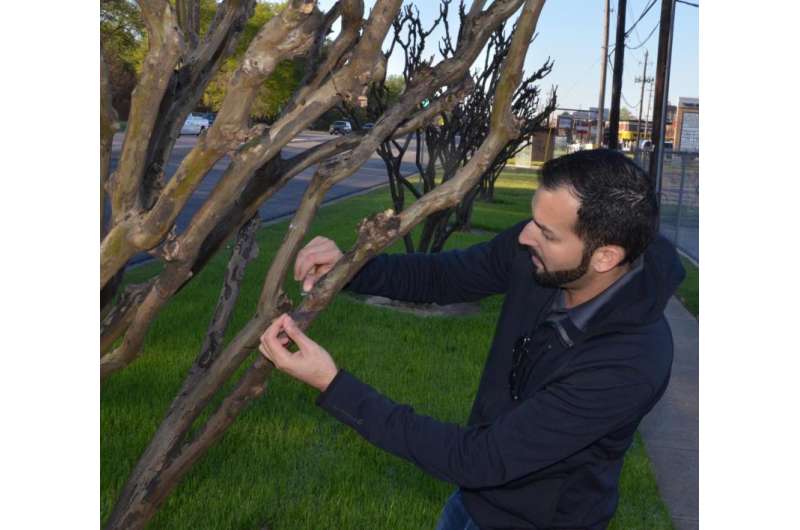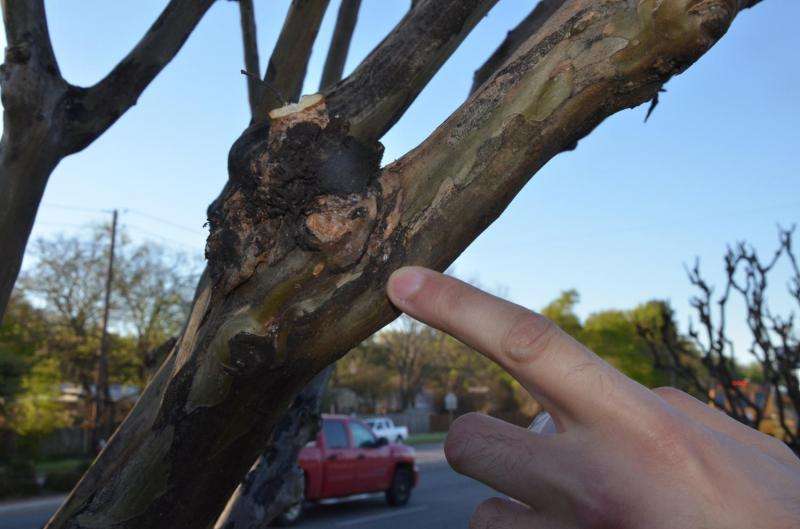Researchers begin tracking crape myrtle bark scale populations

Black, sooty splotches pepper a line of 10 crape myrtle trees along Broadway Avenue in Tyler. The popular ornamental trees wear the tell-tale signs of bark scale infestations.
Erfan Vafaie wrapped five branched on three crape myrtle trees, which is standard protocol for he and the six other researchers studying the bark scale, with double-sided Scotch tape to trap crawlers as they move along the tree.
It's a simple trap but it allows Vafaie, Texas A&M AgriLife Extension Service entomologist in Overton, to monitor pest numbers each week to help determine crape myrtle bark scale's seasonal life cycle and peak crawler activity. The data collected will help researchers develop a strategy against them.
The crape myrtle bark scale, an invasive insect species from Asia, secrete a sugary solution, known as honeydew, that subsequently results in black mold along the branches. The crape myrtle bark scale has not shown to be fatal for plants and has been limited to crape myrtles.
But they do affect the aesthetics for the very popular ornamental tree. Vafaie said observations suggest the crape myrtle bark scale could be responsible for stunted growth in plants and reduced flowering.
Vafaie and several other collaborators are recipients of a three-year funded research project that started last year. He is one of four researchers in Texas who are monitoring the pest, which is relatively new in the state and could potentially affect growers if an uncontrollable infestation occurred on their farm.

Last year crape myrtle bark scale populations peaked in early May at the selected sites, Vafaie said, and populations began ramping up in mid-April.
Systemic treatments should be applied in early April and contact pesticides should be applied at the end of April or early May, Vafaie said.
"That's based on one year of research so it's not a certainty regarding the window, but it should give homeowners an idea of the best time to treat their plants," he said.
Vafaie said the study should help the industry and homeowners deal with the pest.
He said the crape myrtle bark scale are here to stay, but research may identify cultivars with better resistance to the pest and provide a strategic plan to protect plants. In the meantime, Vafaie said, homeowners should be aware of bark scale and educate themselves about potential problems associated with them.
"Crape myrtles are still a successful landscape plant here," Vafaie said. "It's nothing that is going to hurt them other than the aesthetics, which a lot of people don't notice until they look for it."
Producer Jim Berry, of J. Berry Nursery in Grand Saline, agrees. He said individuals should take a holistic approach to their plants since there are a number of diseases and pests, from mildews to aphids and scale, that can prevent the plants from reaching their full potential.
Berry said crape myrtles are a big player among ornamentals and continue to be popular. He said there is very little information about bark scale and its impact on plants, so growers are concerned that the presence of bark scale might affect the crape myrtle market or individual species.
"It's not a crisis for the species," he said. "So, people might see a plant and wonder why it's not thriving. It might be bark scale or something else. That's why it's best for people to take a proactive approach to caring for their crape myrtles."
Provided by Texas A&M University




















